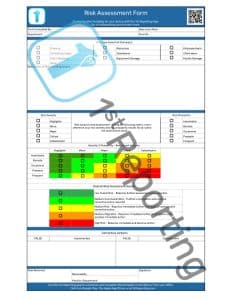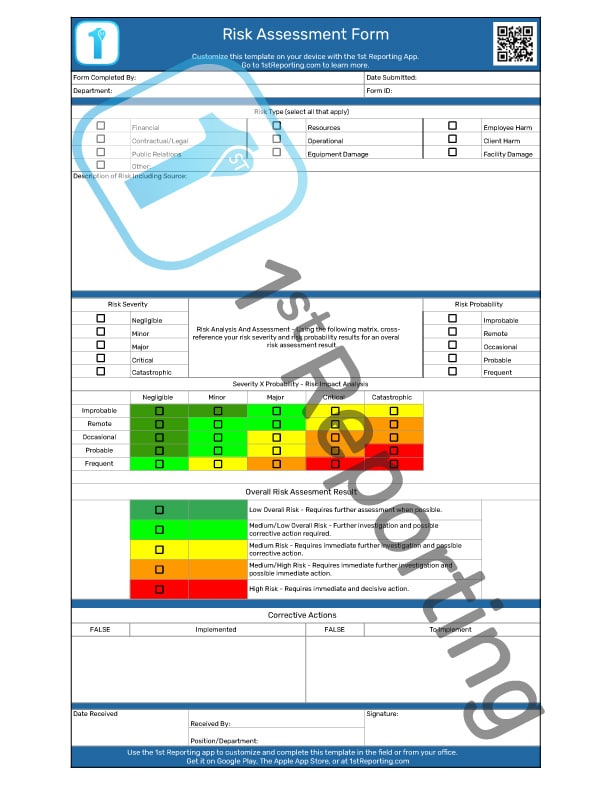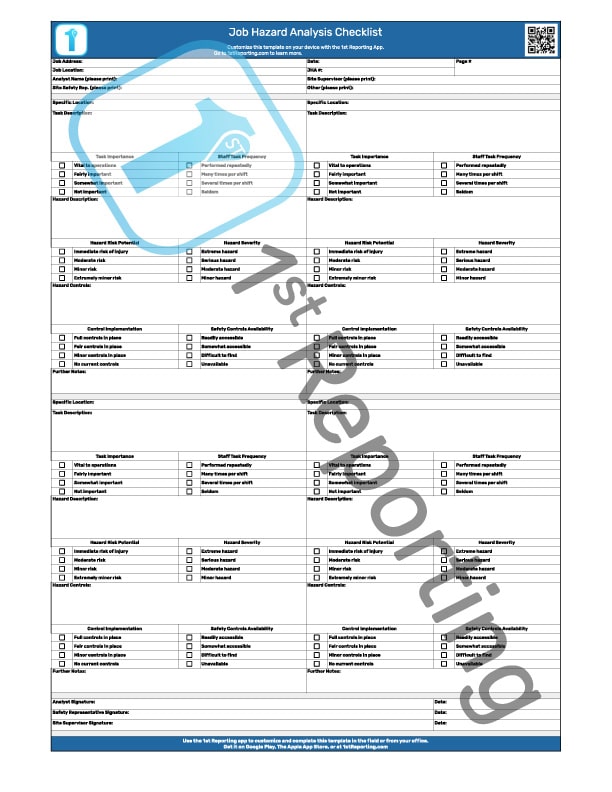
Updated November 14, 2023.
Looking for a Risk Assessment Form? You’re in the right place. Assessing risks within the workplace is a vital part of any health and safety-conscious organization. However, there’s far more to possible risk assessment than merely considering safety-related issues.
Your organization may be tracking risks of various types and levels of risk.
- Financial risks – like investments and loans
- Public relations risks – such as brand tarnishing stories or bad press
- Equipment risks – for example, potential company fleet risks
- Property and building risks – such as roof damage from a wind storm
- Personal injury – risks of slips or falls in a specific area, for example
Organizations face several risks, but how should a business keep track and assess which of these threats is a viable concern. Further still, an organization needs to evaluate how much response and the weight of that response each risk warrants necessary to negate the risk.
To solve this dilemma regarding how to best analyze and assess risk within a business, we’ve created a simple to use, general-purpose risk assessment form. This template can find a use for various risk types to be universal within your organization for a multitude of possible scenarios.
Included In The Risk Assessment Form
The 1st Incident Reporting’s Risk Assessment Form is downloadable and free, easy to use, and includes various sections that help you collect and make sense of the risk. Proper risk analysis is vital to an effective risk assessment strategy.
The First Section Of The Risk Assessment Form – Administrative
The initial section of the form includes the typical administrative information gathering you would expect in any formal document. It consists of the name and position of the individual completing the assessment form, the date of submission, and the form’s assigned ID number.
Risk Type And Description
Further to the administrative information required when processing a risk assessment, the following section includes the risk type and description. This section holds the vital information contained in the risk description.
Risk Severity And Probability
Analyzing a risk involves understanding two factors to the threat – Severity and Probability. Using these two metrics, we can ascertain an overall risk assessment and advise on the type and nature of our response.
This section is for compiling our views on the severity of the risk, or how much ‘damage’ would be caused in a worst-case scenario, and the risk probability, or rather, the likelihood of the hazard resulting in a worst-case scenario.
Corrective Action
The last risk-specific information inclusion section of the Risk Assessment Form is the corrective action section. The section is broken into two halves: immediate actions implemented to control or nullify the risk and actions required to negate or prevent the threat.
Finally, the form ends in a general sign-off section where management may finalize the form’s receipt.
How To Use The Risk Assessment Form

The Risk Assessment Form is a simple-to-use template engineered for various risk types and multiple industry use. Simply download and print the non-watermarked version of our template and provide your staff with a bit of training.
The RAF (risk assessment form) allows staff to quickly collect and organize their thoughts by processing a risk situation via a risk assessment form. The form helps maintain order in chaotic and potentially frightening situations while allowing for documentation and possible preventive action.
Once the form is among your staff, you’ll need to implement a severity matrix of your own relating to your specific industry and situation. Upon completing the staff training, so all team understands how to use the form to document, assess and respond to risks, your company will be that much better protected against threats.
Benefits Of Risk Assessment And Analysis
Risk assessment and analysis are vital to an efficient and effective health and safety policy within an organization. By analyzing risks, we can learn how to prevent them. Preventive action is always more effective than reactive action because reactive means the risk has already resulted in an incident.
Risk assessments and analysis are often something that staff wants someone else to do. Utilizing a streamlined process involving a universal form, such as the Risk Assessment Form we’re providing here, is an excellent way to overcome middle management shying away from decision-making responsibilities.
Further analysis shows that risk assessments, especially those involving health and well-being, provide a versatile tool in our toolbox to fight incidents and, worst of all, injuries in the workplace. In 2019, injury costs in the US alone were $1,097 billion, with 48.3 million injuries, according to the National Safety Council’s Injury Facts website.
Those numbers reflect national injuries in general and in the workplace specifically; 2019 brought about $171 billion in occupational safety injuries and death costs. Deaths totaling 4,572 in 2019 are classified as preventable and documented.
Injuries and death within a workplace are preventable most of the time. However, trying to stop the 48.3 million injuries in 2019 would have been a miracle and highly unlikely ever to happen. The cost, on average, for a medically examined worker who experienced an at-work injury is approximated to be $42,000. Some of this cost may wind up being shouldered by the employers. Indeed, costs to operations slowdowns or stoppages reflect a hidden cost of injury that businesses could again prevent with proper risk assessment protocol.
Calculating the cost of prevention is sort of like calculating the potential worst-case scenario versus the probability of its occurrence and then comparing the cost of the risk to the cost of prevention. Suppose the price of prevention is less than the cost of a worst-case scenario risk scenario. In that case, it makes perfect sense to act in a preventive manner and proactively pursue correction of risks within the work environment.
Proactively documenting risks for assessment and thus, prevention is one of the most intelligent and most effective solutions utilized for preventing incidents within the workplace.
Other Types of Risk Assessment Forms and Reports
Risks come in all forms, including ones you might not think of. That’s why inspections and audits for safety are absolutely essential. Here’s a collection of example forms you can use for your risk assessments:
Risk Assessment and Related Reports Examples
| Environmental Risk Assessment | Site Safety and Conditions Report | Field Report |
| Near Miss Report | Workplace Floor Inspection | GMP Audit Report |
| Facility Safety Inspection | Job Hazard Analysis | Root Cause Analysis |
Our Top 10 Tips For Risk Assessment Best Practices

After inspecting industry standards and how their reporting processes work, several variables in the reporting process are often solved with digital solutions. Still, several human-required actions help any program, digital or otherwise.
We’ve compiled some tips that best suit multiple industries and aid in the risk assessment processes and procedures. These tips can help save organizations both time and money through their direct effects on risk or incident reporting and assessment processes.
- Train And Refresh.
Many employers who employ less than 50 individuals tend to have lax policies regarding training and retraining. Small employers are incredibly guilty of this due to the cost versus the apparent benefit of training staff. Consider the following scenario.
Tom has a small shoe repair shop and employs four staff on rotating part-time schedules. Two of the staff repair shoes, and two act as sales counter staff. The risk to the sales counter staff is minimal, but the tools and nature of the shoe repair mean the risk to the shoe repair staff is much greater. Tom feels that paying the counter staff for a day of watching training videos and doing training tests is a waste of his resources when he’s been in the business for 30 years and has never witnessed an accident for counter staff at work.
If Tom is correct, then more power to him. However, what happens if one of his counter staff merely slipped and fell, injuring themselves potentially quite seriously. If Tom has not adequately trained his staff on slips and falls within the workplace, he may be found liable for the incident he never anticipated occurring. A proper risk assessment of the environment might have revealed a place where shoe polish had fallen on the floor, making it slippery to walk in a particular location.
Proper training and refresher training is imperative to raising employee awareness of risks and dangers in the workplace. It also plays a crucial role in preventing incidents due to staff understanding their role in completing risk assessments within the work environment.
- Identify All Risks.
Overlooking minor risks is something we all do, and we’re all guilty of doing. Take a small oddity in the height of a step. Upon the first encounter, something of this nature is minor but could potentially trip up a person’s natural walking. We encounter it, maybe it registers, perhaps it doesn’t, and we go about our business without a care in the world. The next time, our memory remembers the oddity, and we merely pass over it, unaffected.
The individual who is inexperienced with the oddity in the environment may, upon initial exposure, find themselves in conflict with the anomaly; in this example, they might trip and fall, injuring themselves.
The point is to attempt to identify all potential risks and document them for further analysis. Some may find that they have prevented possible serious injury by merely deciding to take on identifying risks. It could save someone’s life.
- Math Doesn’t Lie.
After documenting risks, it is wise to follow the math. If a particular risk reveals itself repeatedly, the math will tell you the risk is a recurring issue that requires further assessment and possible further action to reach a permanent resolution.
Risks that involve extremely low probabilities may also be considered for archiving rather than acting upon. Again, the analysis of how the numbers show a particular risk’s likelihood and severity of occurrence should tell you how to react and prevent the threat from becoming an actual incident. Never ignore what the numbers tell you; math is without judgment; it simply tells you the way it is.
- Assess and Reassess.
One of the best lessons a manager can learn is to assess and reassess risk. We tend to assess risk and consider it ‘case closed upon completion of our initial assessment. However, often people will overlook one answer when another presents itself more boldly. We may miss a new route to an invisible risk completely when blinded with a seemingly more probable risk delivery scenario.
To prevent such blatant disregard for potential and yet undetermined risk potentials, a practice of re-assessing risks on a semi-regular, perhaps annual basis is a proactive approach to risk exposure and a way we may find new solutions based on new knowledge.
- Reduce Exposure.
As we were just discussing reducing our exposure, ensuring we have a viable, effective, and efficient risk assessment and reporting protocol in place within our organizations reduces our exposure and thus a liability to risk. The only way to reduce risk exposure is via prevention. By the time an incident occurs, we are fully exposed.
- Support A Safety Culture.
Supporting a proactive and possible safety culture within an organization is essential to a successful risk assessment program. Allowing staff of multiple distinctions or levels of management to maintain an active role within a community-like setting at work allows for maximum participation. Maximum participation by staff and contractors alike will dominate any other workplace culture for its ability to report and prevent risks and risk exposure for the company, group, or organization.
- Don’t Be Afraid To Commit.
As we discuss safety culture, many employers will cower in fear over the potential costs of having staff constantly pointing out inadequacies in workplace safety. The more minor, more technical, or more equipment-oriented businesses will feel the sting the most, but all industries will understand the concept. Industries that work with unionized employees may also understand the costs and rigorous involvement required in health and safety practices once your employees start documenting what they feel to be potential risks.
However, an organization should never fear committing to safety and a robust risk assessment program. The cost of injury, incidents, and similar is often enough to close the doors on a small business operation. The cost often outweighs any cost of training and a few preventive measures. Not to mention the potential for workplace shutdowns if the severity of the incident was significant can be devastating to a business’s operations.
- Clarify Responsibilities.
We’ve talked about staff training, but an essential aspect of that training is understanding roles and responsibilities. Any person in management is legally liable for those working under their leadership. It is the view in most courtrooms and most cases. Therefore, it stands to reason that any manager in a place of business should be responsible for completing risk assessments for the sake of their liability.
Many businesses go several steps further by having a health and safety committee and doing regular walk-around of their facilities to identify risks. The Risk Assessment Form is perfect for this sort of scenario, as long as your company provides a printer and a few clipboards.
- Practice Smart Triage.
Risk assessment is the practice of identifying risks and clarifying two aspects of the risks: severity of potential worst-case scenario and its probability. If we acknowledge a requirement for understanding the likelihood, it ties in directly with a manager’s ability to practice intelligent triage.
In any incident situation at a workplace, we must assess the severity of an incident immediately. When deemed severe or life-threatening, immediate action is required. When deemed an improbable and likely minor resulting occurrence, a risk may be considered as adequate for further action at a later date due to a low probability of occurrence.
Determining the level of severity is often straightforward. Determining the potential probability is often problematic. For this reason, it is wise to supplement staff training with an example set to clarify what is considered an emergency and what is considered low risk and improbable. Teach the extreme scenarios to your staff to ensure they understand what’s in between and can practice intelligent triage for risk assessment.
- Don’t Be Afraid To Document.
The last tip we have is one of the most important. People often overlook what they consider to be minor or negligible risks. However, if we miss a possible scenario of severity merely by chance, then we make assumptions that could potentially cost our organization dearly. The lesson here is never to be afraid of documentation. Be afraid of lack of documentation and a lack of action; these spell great exposure for an organization.
The Best Solutions For Risk Assessment Processes Are Digital

Following an examination of process or risk assessment, one thing is clear: Efficient systems that automate processes eliminate errors and support good reporting practices by virtue of the solutions themselves.
Take a digital reporting solution like that offered by 1st Incident Reporting. A business now can utilize a cloud-based app on multiple devices, from Android to Windows, Apple products, and iOS. A cloud-based solution means several advances in the company reporting process.
- Near-instant availability to reports.
- Instant messaging and notification automated to contact the people who need to know.
- Inclusion of media such as photos, videos, and audio for advanced reporting.
- Flexible and customizable solutions are adaptive to multiple business processes.
An organization with a bit of ingenuity and a digital solution like the 1st Reporting App can utilize the app for things like:
- Field reports like Security Shift Reports and Security Patrol Reports
- Field reports like property inspections or Equipment Inspections
- Incident Reporting
- Employee or Visitor Screening Forms
- Near Miss and Dangerous Situation Reporting
- Employee Injury Reporting
- Employee Reasonable Suspicion Checklists
- Vehicle Daily Inspection Reports
- Vehicle Accident Report Forms
- Root Cause Analysis and Safety Leading Indicator reports
You can even use the app to streamline procedures in your organization like the injury reporting process using a digital Procedural Injury Reporting Checklist or a similar customized solution for your business or organization.
Don’t take our word for it. Follow the math, and you’ll see that an automated solution provides seamless interactive experiences from multiple locations without failure. It’s something you just can’t achieve in the old world of paper and filing cabinets.
When you’re ready to test out the future of incident reporting and risk assessment, take a look at the 1st Incident Reporting App – it’s the digital solution your company could use to save time, money and help manage and mitigate risk in an effective and efficient digital solution.





